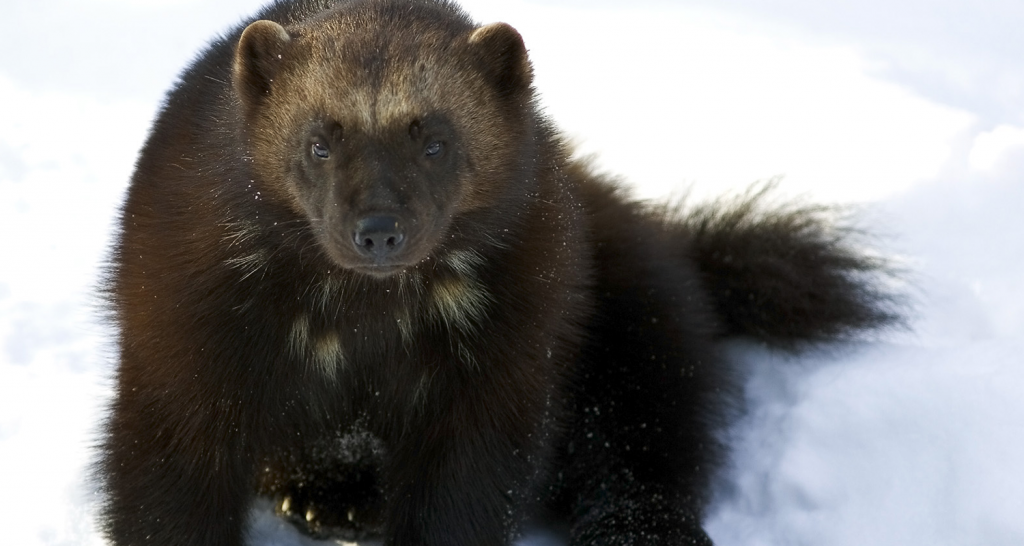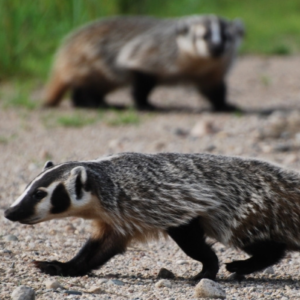
Wolverine Eastern population Nature Canada
The Labrador Wolverine Working Group, formed in 2000, has agreed that natural recovery of the Wolverine is unlikely.
Vital Signs
Common name: Wolverine, Eastern population Latin name: Gulo gulo Status under SARA: Endangered, 2014 COSEWIC assessment: Endangered. Range: Labrador and Quebec (eastern population) Life Span: 17 years Size: Adult males weigh approximately 14 kg; females, 9 kg. Adult males are approximately 1 m long, females are shorter. Population Estimate: Fewer than 50
The Facts
- Although it belongs to the weasel family, the Wolverine resembles a powerful, miniature bear. Its fur is usually dark brown with its head and tail lighter in colour. Two tan stripes run from the neck along the sides meeting at the tail. Its long, curved claws are semi-retractile and used for climbing and digging.
- The Wolverine’s powerful teeth and jaws are adapted for crushing the frozen meat they scavenge in winter. They will even eat frozen bones and pelts when desperate. In summer they eat berries and vegetation too.
- Wolverines are known for traveling long distances. Their range extends from less than 100 km2 for females to more than 1000 km2 for males. These are the largest reported home ranges for a carnivore.
- The Wolverine is known by a variety of descriptive names: “skunk-bear” because it marks its food and various landmarks with urine and musk, a fluid secreted by its anal glands; and “glutton” because of its voracious appetite. Carcajou is its French Canadian name.
- Females give birth and raise their kits in a den. Most dens have been found in tundra regions and consist of complex snow tunnels that have formed naturally around rock configurations.
- When food is scarce, a high percentage of the population will not have young. Females have a delayed implantation mechanism that allows them to have young when food is most abundant and to adjust the size of the litter to the availability of food.
- Wolverines are non-migratory and do not hibernate during the winter. They are active day and night, and they alternate three to four hour periods between activity and sleep.
The Story
Although the Wolverine is known as a clever trickster-hero and a link to the spirit world in First Nations’ mythology, its eastern population may not have been able to find a way to stay in our earthly one.
For years, the eastern population of Wolverines was hunted for its frost-resistant fur, ideal for lining parkas, and its pesky habit of raiding hunters’ trap lines made it vulnerable. Its population continued to decline as its main food source, the Caribou, failed in Labrador and Quebec and as humans continued to hunt it.
Today, the eastern population of Wolverines is one of the most misunderstood and least known of Canada’s wild animals.
Michel Huot, chair of the Wolverine Recovery Team (Eastern Population) in Quebec, says the animal closely resembles porcupines, Fishers and even small bears, making it difficult to identify without a blood or tissue sample. “The first time I saw a Wolverine in a zoo,” says Huot, “I was sure it was a Fisher – and I had studied the animal extensively.”
Although, there have been no verified reports of Wolverines in Quebec since 1978, and none in Labrador since the mid-1950s, there are unconfirmed reports every year. It is believed any remaining population is extremely small and, therefore, at high risk of extinction.
“This animal is very difficult to help,” says Huot, “because it is so rare in the vast, unpopulated areas of Quebec and Labrador.”
The Wolverine’s apparent lack of recovery despite the recent high local abundance of Caribou suggests that this population may already be extirpated. There is some possibility, however, of a small pocket of Wolverines in the Lac-Saint-Jean region of Quebec, 200 km north of Quebec City, where there have been repeated sightings. If there is a population of Wolverines in that area, it is thought to be separate from the rest of the range.
Lack of habitat is not a problem for the eastern population of Wolverines, but a population that is too low to allow for natural recovery may be its single biggest challenge.
What is Being Done
The Labrador Wolverine Working Group, formed in 2000, has agreed that natural recovery of the Wolverine is unlikely. Isabelle Schmelzer, ecologist with the Department of Environment and Conservation and member of the working group, says introducing wild caught Wolverines from Ontario, the nearest genetic group, may be the best option for Labrador.
In 2004, experts performed an aerial survey of 195,000 km2 of wilderness, but did not find any trace of Wolverines. Since 2003, the group has tried to collect hair samples of Wolverines with hair poles – poles wrapped in barbed wire and topped with carrion. No samples have been collected to date, but Schmelzer says there is great interest in the program and more poles will be deployed at the end of this winter when Wolverines should be hungriest.
The group has also been hosting public meetings and workshops requested by the Labrador Innu who were interested in learning about the Wolverine from those who had worked with it.Unfortunately, the aboriginals of the James Bay Agreement Management Group in northern Quebec are not interested in bringing the Wolverine back to their forests.
“They look at the Wolverine as another fur-bearer resource,” says Huot. “As we indicate that the Wolverine won’t be an important fur-bearer resource in the future because, naturally, the animal is rare and the skins are not of important value, they aren’t interested in being involved with the return of the Wolverine.”
The Wolverine Recovery Team did not meet in 2006, but Huot says they do hope to present another working plan to the aboriginals this year that will create interest in Wolverine recovery.
What You Can Do
- Inform the Wolverine Recovery Team (Eastern Population) of any Wolverine sightings in Quebec at 418-627-8694 ext. 7435. In Labrador, contact the Labrador Wolverine Working Group at 709-637-2970.
- If you see a Wolverine, make a mental note of its behaviour, approximate measurements, and appearance in order to write a detailed report later.
- Avoid capturing a Wolverine, especially in the Lac-Saint-Jean area of Quebec, which is believed to be home to a pocket of Wolverines. If hunting, use small traps to avoid its accidental capture.
- If you believe you are within the vicinity of a Wolverine, move away from the area.
Resources:
Species at Risk Registry (SARA) COSEWIC Assessment
This spotlight was written by Melanie Furlong.
Want to Help?
Hello nature life wilderness is the world’s envy. It’s our duty to keep our true north strong and green.
Donate

